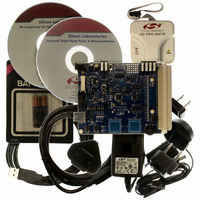C8051F930DK Silicon Laboratories Inc, C8051F930DK Datasheet - Page 115

C8051F930DK
Manufacturer Part Number
C8051F930DK
Description
KIT DEV C8051F920,F921,F930,F931
Manufacturer
Silicon Laboratories Inc
Type
MCUr
Specifications of C8051F930DK
Contents
Target Board, Power Adapter, USB Debug Adapter, Cables, Batteries, and Software
Processor To Be Evaluated
C8051F930
Processor Series
C8051F9xx
Data Bus Width
8 bit
Interface Type
I2C, UART, SPI
Maximum Operating Temperature
+ 85 C
Minimum Operating Temperature
- 40 C
Operating Supply Voltage
0.9 V to 3.6 V
Lead Free Status / RoHS Status
Lead free / RoHS Compliant
For Use With/related Products
C8051F920, F921, F930, F931
Lead Free Status / Rohs Status
Lead free / RoHS Compliant
Other names
336-1473
Available stocks
Company
Part Number
Manufacturer
Quantity
Price
Company:
Part Number:
C8051F930DK
Manufacturer:
Silicon Labs
Quantity:
135
- Current page: 115 of 324
- Download datasheet (3Mb)
10.4. Multiplexed External Memory Interface
For a Multiplexed external memory interface, the Data Bus and the lower 8-bits of the Address Bus share
the same Port pins: AD[7:0]. For most devices with an 8-bit interface, the upper address bits are not used
and can be used as GPIO if the external memory interface is used in 8-bit non-banked mode. If the
external memory interface is used in 8-bit banked mode, or 16-bit mode, then the address pins will be
driven with the upper 4 address bits and cannot be used as GPIO.
Many devices with a slave parallel memory interface, such as SRAM chips, only support a non-multiplexed
memory bus. When interfacing to such a device, an external latch (74HC373 or equivalent logic gate) can
be used to hold the lower 8-bits of the RAM address during the second half of the memory cycle when the
address/data bus contains data. The external latch, controlled by the ALE (Address Latch Enable) signal,
is automatically driven by the External Memory Interface logic. An example SRAM interface showing
multiplexed to non-multiplexed conversion is shown in Figure 10.2.
This example is showing that the external MOVX operation can be broken into two phases delineated by
the state of the ALE signal. During the first phase, ALE is high and the lower 8-bits of the Address Bus are
presented to AD[7:0]. During this phase, the address latch is configured such that the Q outputs reflect the
states of the D inputs. When ALE falls, signaling the beginning of the second phase, the address latch
outputs remain fixed and are no longer dependent on the latch inputs. Later in the second phase, the Data
Bus controls the state of the AD[7:0] port at the time RD or WR is asserted.
See Section “10.6. External Memory Interface Timing” on page 118 for detailed timing diagrams.
I
E
F
M
AD[7:0]
A[11:8]
Figure 10.1. Multiplexed Configuration Example
ALE
WR
RD
ADDRESS BUS (12-bit or 8-bit)
DATA BUS
Rev. 1.1
GPIO (4-bit)
(Optional)
C8051F93x-C8051F92x
V
DD
8
CS
RD
WR
ALE
AD[7:0]
(8-bit Interface)
LEDs/Switches
Controller
Ethernet
115
Related parts for C8051F930DK
Image
Part Number
Description
Manufacturer
Datasheet
Request
R
Part Number:
Description:
SMD/C°/SINGLE-ENDED OUTPUT SILICON OSCILLATOR
Manufacturer:
Silicon Laboratories Inc
Part Number:
Description:
Manufacturer:
Silicon Laboratories Inc
Datasheet:
Part Number:
Description:
N/A N/A/SI4010 AES KEYFOB DEMO WITH LCD RX
Manufacturer:
Silicon Laboratories Inc
Datasheet:
Part Number:
Description:
N/A N/A/SI4010 SIMPLIFIED KEY FOB DEMO WITH LED RX
Manufacturer:
Silicon Laboratories Inc
Datasheet:
Part Number:
Description:
N/A/-40 TO 85 OC/EZLINK MODULE; F930/4432 HIGH BAND (REV E/B1)
Manufacturer:
Silicon Laboratories Inc
Part Number:
Description:
EZLink Module; F930/4432 Low Band (rev e/B1)
Manufacturer:
Silicon Laboratories Inc
Part Number:
Description:
I°/4460 10 DBM RADIO TEST CARD 434 MHZ
Manufacturer:
Silicon Laboratories Inc
Part Number:
Description:
I°/4461 14 DBM RADIO TEST CARD 868 MHZ
Manufacturer:
Silicon Laboratories Inc
Part Number:
Description:
I°/4463 20 DBM RFSWITCH RADIO TEST CARD 460 MHZ
Manufacturer:
Silicon Laboratories Inc
Part Number:
Description:
I°/4463 20 DBM RADIO TEST CARD 868 MHZ
Manufacturer:
Silicon Laboratories Inc
Part Number:
Description:
I°/4463 27 DBM RADIO TEST CARD 868 MHZ
Manufacturer:
Silicon Laboratories Inc
Part Number:
Description:
I°/4463 SKYWORKS 30 DBM RADIO TEST CARD 915 MHZ
Manufacturer:
Silicon Laboratories Inc
Part Number:
Description:
N/A N/A/-40 TO 85 OC/4463 RFMD 30 DBM RADIO TEST CARD 915 MHZ
Manufacturer:
Silicon Laboratories Inc
Part Number:
Description:
I°/4463 20 DBM RADIO TEST CARD 169 MHZ
Manufacturer:
Silicon Laboratories Inc











